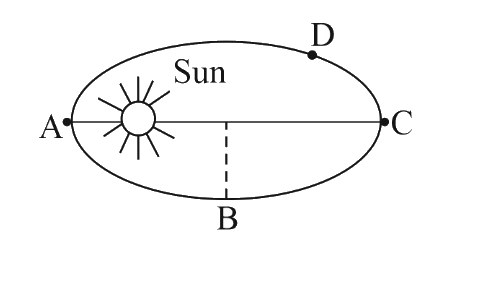Planets move round the sun due to
Mutual attraction and repulsion between sun and planet
frictional force
centrifugal force
gravitational attraction between the sun and planets
The correct Answer is:D
To solve the question "Planets move round the sun due to", we will analyze the options provided and determine the correct reason for the motion of planets around the sun.
1. Understanding the Motion of Planets:
- Planets revolve around the sun in a circular or elliptical orbit. This motion is governed by forces acting on the planets.
2. Analyzing the Options:
- Option 1: Mutual attraction and repulsion between sun and planet:
- This option suggests that both attraction and repulsion are at play. However, in the context of planetary motion, there is no significant repulsive force acting between the sun and planets.
- Option 2: Frictional force:
- Frictional force is not relevant in the vacuum of space where planets move. There is no medium to create friction between the planets and the sun.
- Option 3: Centrifugal force:
- Centrifugal force is a perceived force that acts outward on a mass moving in a circular path. It is not a real force but rather a result of inertia. It does not cause the planets to move around the sun.
- Option 4: Gravitational attraction between the sun and planets:
- This option states that the gravitational force is responsible for the motion of planets. According to Newton's law of universal gravitation, every mass attracts every other mass. The sun, being a massive body, exerts a gravitational force on the planets, keeping them in orbit.
3. Conclusion:
- After analyzing all the options, the correct answer is Option 4: Gravitational attraction between the sun and planets. This gravitational force is what keeps the planets in their orbits around the sun.
Final Answer:
Planets move round the sun due to gravitational attraction between the sun and planets.
---
- Planets revolve around the sun in a circular or elliptical orbit. This motion is governed by forces acting on the planets.
- Option 1: Mutual attraction and repulsion between sun and planet:
- This option suggests that both attraction and repulsion are at play. However, in the context of planetary motion, there is no significant repulsive force acting between the sun and planets.
- Option 2: Frictional force:
- Frictional force is not relevant in the vacuum of space where planets move. There is no medium to create friction between the planets and the sun.
- Option 3: Centrifugal force:
- Centrifugal force is a perceived force that acts outward on a mass moving in a circular path. It is not a real force but rather a result of inertia. It does not cause the planets to move around the sun.
- Option 4: Gravitational attraction between the sun and planets:
- This option states that the gravitational force is responsible for the motion of planets. According to Newton's law of universal gravitation, every mass attracts every other mass. The sun, being a massive body, exerts a gravitational force on the planets, keeping them in orbit.
- After analyzing all the options, the correct answer is Option 4: Gravitational attraction between the sun and planets. This gravitational force is what keeps the planets in their orbits around the sun.
Planets move round the sun due to gravitational attraction between the sun and planets.
Similar Questions
Knowledge Check
A planet revolves around the sun in an elliptical orbit. Suppose that the gravitational attraction between the sun and the planet suddenly disappear then the planet would move
Atowards the sun in a spiral pathBaway from the sun along a straight path with continuously increasing speedCwith constant speed along a tangential path to the oribtDtowards the sun along a straight path with constant speedA planet revolves around the sun in elliptical orbit of eccentricity 'e'. If 'T' is the time period of the planet then the time spent by the planet between the ends of the minor axis and major axis close to the sun is
ATπ2eBT(2eπ−1)CTe2πDT(14−e2π)A planet revolves around the sun in an elliptical orbit. If vp and va are the velocities of the planet at the perigee and apogee respectively, then the eccentricity of the elliptical orbit is given by :
AvpvaBva−vpva+vpCvp+vavp−vaDvp−vavp+va
A planet is moving round the sun in an elliptical orbit as shows. As the planet moves from A to B

View SolutionMost of the comets moving round the sun have orbits of the shape of
View SolutionA planet revolves around the sun in an elliptical . The linear speed of the planet will be maximum at

View SolutionKepler's law starts that square of the time period of any planet moving around the sun in an elliptical orbit of semi-major axis (R) is directly proportional to
View SolutionA planet is revolving round the sun in an elliptical orbit, If v is the velocity of the planet when its position vector from the sun is r, then areal velocity of the planet is
View Solution
